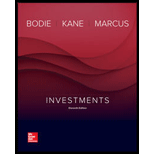
(A)
To calculate:
Theoritical future price in accordance with sport future partity
Introduction:
Future price refers to the price pertaining to which two parties transact the commodity at a predeteromed price at a specific date in the future. It represents the price of commodity or stock on future contract in comparison to the current or spot price.
(B)
To determine:
The strategy that can be taken into consideration by investor to ascertain benefit out of the mispricing in future, if any
Introduction:
The future contract refers to the financial contract which is standardized in nature and is made between two parties wherein one party provide consent to sell or purchase the commodity at a particular date in the future and at a particular price to the other party which provide consent to purchase or sell the same. In the futures contract the physical delivery of the commodity does not take place.
Want to see the full answer?
Check out a sample textbook solution
Chapter 21 Solutions
Investments
- The relationship of required rate of return and risk shows the linearity in the: a.None of these b.Capital market line c.Security market line d.Asset market linearrow_forwardPurchasing power of risk hit the investor when there are chances that the: a.None of these b.Real return on a security is equal to the nominal return c.Real return on a security is less than the nominal return d.Real return on a security is more than the nominal returnarrow_forwardneed help by real expert and true answer...arrow_forward
- What is the full form of "YTD"? a.Yield of Divergence b.Year to Delivery c.Year-to-date d.Yield to Debitarrow_forwardQuestion Three A company needs $10,000 in 5 years to replace a piece of equipment. How much must be invested now at an interest rate of 8% p.a. compounded daily in order to provide for this replacement?arrow_forwardYear Free Cash Flow (FCF) 0 -$17,000,000 1 $4,980,000 2 $4,980,000 3 $4,980,000 4 $4,980,000 5 $6,980,000 The Net Present Value at a discount rate of 15%: Present Value (PV) for each year: PV(Year 1) = $4,980,000 ÷ (1 + 0.15)^1 = $4,330,435. PV(Year 2) = $4,980,000 ÷ (1 + 0.15)^2 = $3,765,590. PV(Year 3) = $4,980,000 ÷ (1 + 0.15)^3 = $3,274,426. PV(Year 4) = $4,980,000 ÷ (1 + 0.15)^4 = $2,847,328. PV(Year 5) = $6,980,000 ÷ (1 + 0.15)^5 = $3,477,617. Sum of PVs = $4,330,435 + $3,765,590 + $3,274,426 + $2,847,328 + $3,477,617 = $17,695,396. Initial Investment = $17,000,000. NPV = Total PV - Initial Investment = $17,695,396 - $17,000,000 = $695,396. Calculate The Internal Rate of Returnarrow_forward
 Intermediate Financial Management (MindTap Course...FinanceISBN:9781337395083Author:Eugene F. Brigham, Phillip R. DavesPublisher:Cengage Learning
Intermediate Financial Management (MindTap Course...FinanceISBN:9781337395083Author:Eugene F. Brigham, Phillip R. DavesPublisher:Cengage Learning

